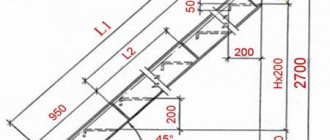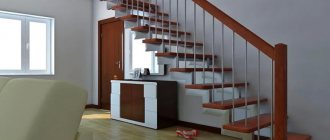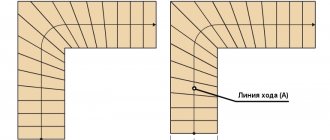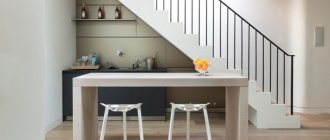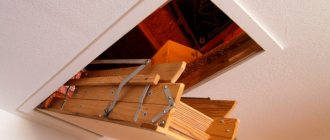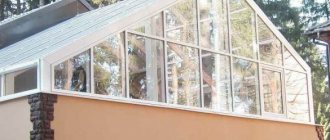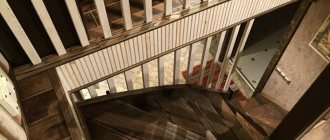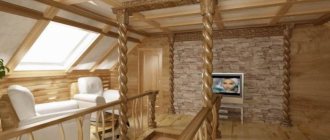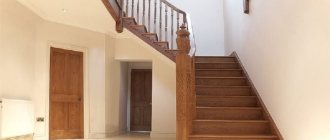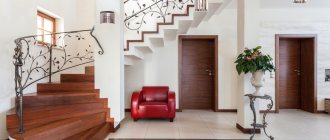Photo: theply.ru The interfloor staircase is a fairly large structure, and therefore immediately becomes a significant part of the interior. A high-quality building for lifting should not only be comfortable and safe, but also aesthetically pleasing. Read about how to take all these parameters into account, as well as how to rationally use the space under the stairs!
Types of stairs
The first thing you need to decide before installing a staircase is its design features. Based on this parameter, three large types can be distinguished: marching, screw and bolt-on.
Marching stairs
This is the most common type of staircase. It is convenient to ascend and descend using the main structure, which is not always the case, for example, with a screw structure. At the same time, the mid-flight lift requires a large amount of space for installation.
To make such a staircase as convenient to use as possible, take into account several nuances: the ascent angle is about 45 degrees, the number of steps without a flight is from 3 to 15, the depth of the steps should be comparable to the length of a human foot (at least 25 cm), and the height is 16 -18 cm.
Spiral staircases
As already mentioned, the screw variation is not entirely comfortable to use, but it is very compact and beautiful. As a rule, the structure is placed in a circle with a center at the support post and a radius equal to the length of the step.
If the length is 1 m, then the area occupied by this staircase will be one and a half times less than the flight staircase. But already with a length of 1.5 m, the use of a screw structure is not entirely justified, since the required space is equivalent to a straight staircase.
Stairs on rails
Stairs on rails appeared relatively recently - in the second half of the twentieth century. They look modern and light, but don’t be fooled by their fragile appearance – this design is reliable and durable.
The fence and steps are fixed with bolts on the wall, or supported on a steel rod support. It is noted that each stage can withstand a weight of more than 1500 kg.
Another pleasant bonus is that wooden stairs with this design do not creak. This effect is achieved due to the lack of contact of wooden elements with each other.
Distinctive features
Despite the variety of building materials that the modern market offers, wood remains the most popular option for the construction of private houses and decoration.
The popularity of the material is explained simply. Wood naturally has an original texture and in most cases does not require finishing. Several layers of varnish - and the surface acquires a bright and aesthetic appearance. In addition, only wood can create an atmosphere of comfort and harmony, making the house truly alive.
If we talk about specifics, the advantages of using solid wood in private construction look like this:
- absence of chemically active substances - absolute environmental friendliness and health benefits: resin from coniferous trees is often used in aromatherapy to treat colds;
- ease of processing - no technically complex and expensive equipment is required: wood can be sawed, planed and chopped, any visual defects can be easily removed from the surface;
- durability - many tree species are not inferior in strength to brick, and after treatment with special compounds they become neutral to a humid environment and do not attract pests;
- reliability - contrary to popular belief, it is very difficult to destroy a tree. The fibrous structure is resistant to mechanical damage and intense dynamic loads.
Despite its apparent simplicity, wood is a very variable material and even in the budget segment of the market there are more than 10 different solid textures.
Staircase style and design
In order for the rise to look appropriate and become a logical continuation of the interior decoration of the house, it is necessary to select the structure in a single style.
Modern style
The staircase to the second floor in a modern style must comply with the basic tenets of this design trend. Clear and strict forms, basic color schemes, absence of unnecessary details, modern materials - if all this can be said about the building, then it will definitely fit into this context.
Classical
In the case of a classic interior, almost everything works the other way around. Round and smooth lines prevail here, and decorative elements are also appropriate. The styles come into contact only in calm colors and restraint.
Traditional stairs look beautiful in wood and stone. It is worth giving preference to natural materials or their high-quality artificial analogues.
The spiral staircase with openwork railings will definitely not go unnoticed. You can also opt for a marching variation with forged railings and a grandiose mirror decorating the span.
Loft
Rough surfaces are suitable for an industrial style. For example, you can choose a staircase made of black metal with large wooden steps that match the color of the floor and other wood in the interior.
Scandinavian
The stylistic solutions that came to us from snowy Scandinavia are different. This can be either rustic or modern urban design.
In a country house, give preference to the usual flight of stairs on stringers, made in light colors. But for a modern two-story apartment and a private house, a lightweight structure on light wood rails is suitable.
Nautical
The nautical style has many similarities with the Scandinavian one. White, light shades, as well as wooden surfaces are also welcome here. But you can indicate the style using details. For example, ropes.
Polycarbonate gazebos: design ideas (70 photos)
Price
It is quite difficult to determine the final cost of such a structure:
- Firstly, the degree of complexity of construction work can only be determined during its actual implementation.
- Secondly, it is quite difficult to indicate the amount of costs for the preparatory processing of a log before its use. Thus, the construction of a staircase structure is a rather serious task, the implementation of which must be approached with all responsibility.
Materials
The staircase to the second floor is a global building that will remain in the interior for a long time. Therefore, it is important to choose reliable and high-quality materials that fit into the overall ensemble of the environment.
Metal stairs
The metal structure will perfectly complement a room decorated in a modern style. The material itself has high strength and durability characteristics. So, a stainless steel staircase will last about 50 years.
But painted or chrome-plated steel options are not so durable - they are unlikely to please the owner for more than 5 years. Among the less successful materials are brass and aluminum, since after some time they can darken and become deformed due to their softness.
Wooden stairs
Wooden stairs look warm and cozy. They fit most organically into the interiors of country cottages in rustic, Scandinavian and even classical styles.
However, wooden steps can be present in other stylistic solutions, of course, if the room already has wood surfaces with which they can overlap.
A large number of wood species are suitable for constructing stairs: beech, maple, teak, walnut, ash. You should choose individually, based on your budget and desired characteristics.
Stairs made of stone
Stone is durable, reliable and beautiful. Granite and marble stairs become the central element of the composition of any interior - from democratic modern to aristocratic classic.
Stone surfaces do not require special care - wet cleaning is sufficient. They are not afraid of temperature changes and exposure to moisture. Among the disadvantages: price (can be replaced with artificial material); cold (it is enough to lay a carpet); weight (everything is in order if it is a house with a solid foundation, otherwise you can use a structure made of a different material and install stone overlays).
Concrete stairs
Concrete surfaces do not look light and airy, they do not seem to be trying to please us, and this is their charm. A staircase made of this material is suitable for modern and loft interiors. And with additional finishing, it will complement even the classic design (concrete can be disguised as marble).
With timely repairs, concrete can last a very, very long time. Another advantage is the fact that a concrete marching structure will cost less than wood and metal ones. Moreover, such a staircase is not so difficult to build yourself. Disadvantages include the inability to dismantle and heavy weight.
Glass stairs
A glass staircase is an ideal continuation of a modern interior. It does not burden the design due to its transparency. On the contrary, the glossy surface reflects light, thereby visually increasing the space.
For convenience and aesthetics, such a staircase can be illuminated with LED strip in the dark. To prevent the steps from slipping, you can install rubber or wooden inserts.
Preparatory work with wood before installation
In order to get a high-quality staircase structure and last as long as possible during operation, it is necessary to properly process the logs before the installation stage.
Stages of wood preparation and processing
- We dry the wood; the logs should be moderately dry, not overdried. Wet wood is susceptible to early rotting and mold, while wood that is too dry is deformed and cracks, which leads to loss of strength.
- To reduce the cost of processing the material (antiseptic, varnish), we saw the logs to size, to the required length, and remove knots and bark.
- If you are planning a staircase made of half-logs, then we cut the logs for the steps in advance in the center, along the axis in half, before pre-processing them.
- A staircase made of rounded logs, namely future steps, stringers or bowstrings (depending on the chosen design) are sawn only to the required length.
- We treat the prepared logs with an antiseptic solution to disinfect and prevent the formation of fungus and mold.
- If the staircase is external, areas of the logs in contact with the ground must be treated with resin, which will prevent it from rotting from moisture and protect against the penetration of various bugs into the wood.
- The final stage of processing is to cover the logs with paint and varnish material to protect them from external irritants.
By doing all of the above, you will maximize the service life of the staircase structure, protect it from the effects of temperature changes, high humidity, and the formation of mold and mildew.
Space under the stairs: put to good use
So, we have already decided that the flight of stairs, and in a sense the analogue on the rails, takes up a considerable amount of space. Why not figure out how to put the remaining space to good use? Here's what can fit here:
Pantry.
If someone in the house is fond of preparing cucumbers or jam for the winter, then you can equip a pantry for appetizing supplies;
Laundry.
Household appliances require space. It is in the staircase that you can build a washing machine and dryer, and also take care of the placement of the ironing board, iron and household chemicals;
Cabinet.
A quiet corner is what you need for work and homework. You just have to take care of quality lighting;
Wardrobe.
You can store shoes and clothes in the stairs. Large storage systems will keep things tidy and clean;
Game room.
Children love all kinds of huts and shelters, so you can give this useful space to them.
8 Free Interior Design Software
Where to place the stairs
It is necessary to decide where best to place the staircase at the design stage. The staircase to the second floor is a fairly large building that can affect the entire composition of the interior. Potential dangers you may encounter are cluttered spaces and lack of natural light.
Therefore, in the case of a small room, it is better to install a lightweight version on rails or a spiral staircase. By the way, the latter can even be placed in the center of the room.
But for the rest, a place in the corner or along the wall is suitable. Of course, if we are not talking about a grandiose grand staircase in a big house. In general, it is most convenient to install a staircase in a passage room, so as not to disturb resting household members.
Staircase to the second floor - photos of real interiors
We tried to highlight the main points that one encounters when designing a staircase to the second floor. Even more ideas for the design and placement of a modern rise can be found in the photo selection below. Enjoy watching!
80 living room design ideas in Khrushchev (photo)
Dyeing technology
Painting the stairs is carried out in several stages:
- Preparatory. To begin with, the surface will need to be leveled by puttying and sanding. After this, you need to apply a primer solution to it twice;
Sanding all wooden elements
- Coloring. The process of painting the stairs takes place in 2-3 layers. Moreover, a new layer of paint is applied along the wood fibers.
Step-by-step painting
And this can only be done when the previous layer has dried, which must be applied across the wooden fibers;
- Opening with varnish. Varnish is applied to the wood using a sprayer when it is necessary to paint wide parts of the staircase, and using a thin brush for narrow staircase elements.
Photo of applying varnish to the steps of a staircase.
The surface is first cleaned and polished. If there are any visible defects, you can use wood-colored putty. (see also the article Painting pine stairs: selection of paints and varnishes and technology)
